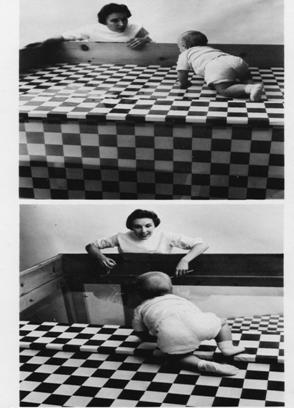 E.吉布森(1910-),
E.吉布森(1910-),
美国发展心理学家,主要从事婴儿的知觉发展、儿童阅读技巧发展和动物行为的研究。她提出的“差别理论”(Differentiation
theory)和发明的用来测量婴儿深度知觉的工具――“视崖”十分著名。曾荣获国家科学奖,1968年获美国心理学会颁发的杰出科学贡献奖,1971年当选为国家科学院院士。
 知觉学习和发展的原理
知觉学习和发展的原理
(美)吉布森 著,李维,李季平 译
浙江教育出版社
原 价:21.50
共分三个部分:第一部分涉及知觉学习的理论。第二部分主要介绍知觉学习的实验,这些实验分为四类,它们分别为知觉学习的选择性因素和分化性因素,练习对改进知觉技能的影响,刺激排列条件下的知觉实验,以及形态之间的迁移。第三部分专门论述知觉的发展,既包括种系的发生,也包括个体的发生。
相关链接
理论关键词
差别理论 Differentiation theory
视觉悬崖 visual cliff
Experimental psychologist noted for her work in the field of
perceptual development in children and infants.
 In 1975 Gibson was able to establish her own infant study laboratory.
This enabled her to devote her research to ecological psychology,
perhaps even more so after her husband's death in 1979. She has
pursued her work on perceptual development, more recently concentrating
on the concept of affordance. Gibson's major published work is possibly
An Odyssey in Learning and Perception, (1991), which consolidates
much of her lifetime's work. She also wrote Principles of Perceptual
Learning and Development, in 1967, for which she received the Century
Award.
In 1975 Gibson was able to establish her own infant study laboratory.
This enabled her to devote her research to ecological psychology,
perhaps even more so after her husband's death in 1979. She has
pursued her work on perceptual development, more recently concentrating
on the concept of affordance. Gibson's major published work is possibly
An Odyssey in Learning and Perception, (1991), which consolidates
much of her lifetime's work. She also wrote Principles of Perceptual
Learning and Development, in 1967, for which she received the Century
Award.
Gibson, along with her husband, J.J. Gibson, argued that perceptual
learning was done through a process called differentiation. Before
perceptual learning, we over-generalize and see things similarly
to each other. As we develop perceptual learning we can make distinctions
between objects and events that we were not able to make initially.
Simply, as young children, we easily confuse stimuli with one another,
but with repetition, the stimuli eventually become differentiated
from one another (Benjafield, 1996, p. 259).
Probably the most well known contribution of E.J. Gibson is the
visual cliff. The visual cliff was developed to investigate the
process of depth perception, or seeing objects in three dimensions.
E.J. Gibson and Richard Walk (1960) studied infant’s depth perception
by using a small cliff with a drop-off covered by glass. Gibson
and Walk would then place 6-14 month old infants on the edge of
the visual cliff to see if they would crawl “over the edge”. Most
infants refused to crawl out on the glass signifying that they could
perceive depth and that depth perception is not learned
http://teach.psy.uga.edu/dept/student/parker/PsychWomen/Gibson.htm
http://www.findarticles.com/cf_dls/g2699/0004/2699000482/p1/article.jhtml
